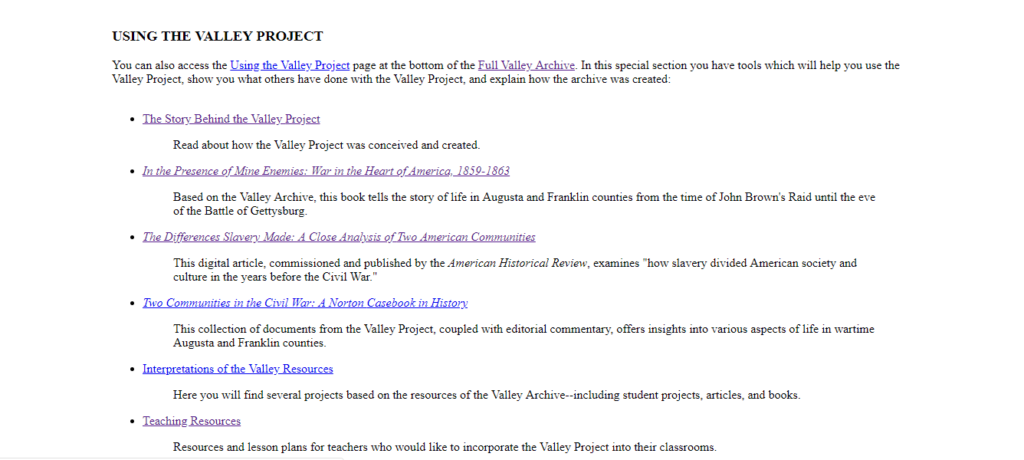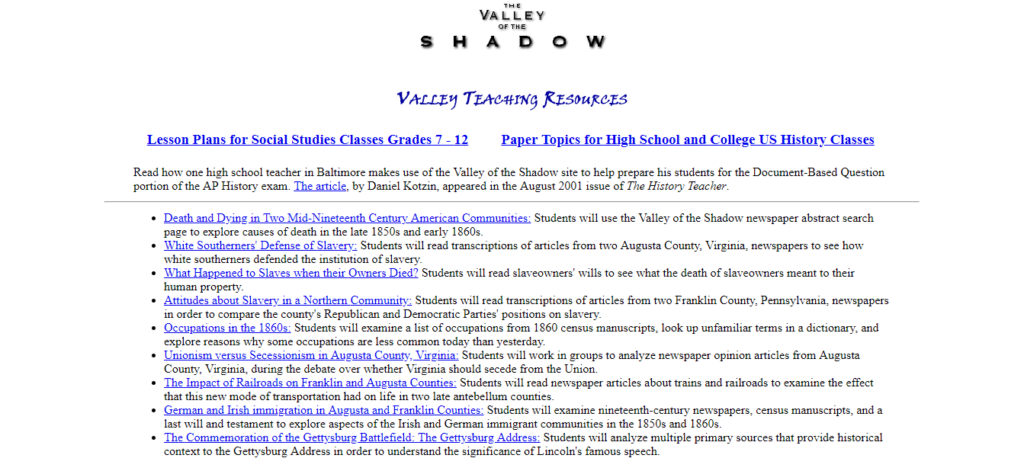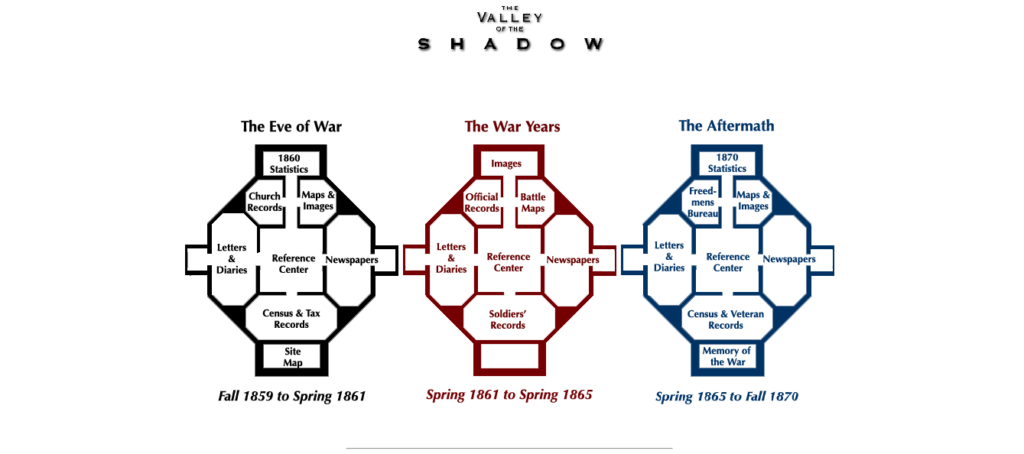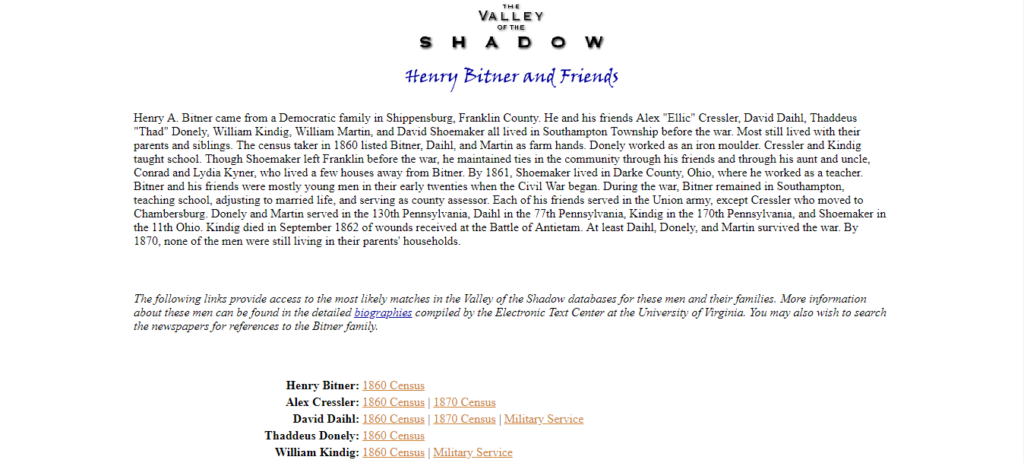Review: The Valley of the Shadow
The Valley of the Shadow: Two Communities in the American Civil War. http://valley.lib.virginia.edu/. Created and archived by Edward L. Ayers, the Virginia Center for Digital History, the Institute of Advanced Technology in the Humanities, and the University of Virginia Library. http://valley.lib.virginia.edu/VoS/usingvalley/background.html. Reviewed February 5, 2019.
The Valley of the Shadow is an online database consisting of thousands of letters, diaries, newspapers, and other records left by the residents of Augusta County, Virginia, and Franklin County, Pennsylvania. The project details the lives of hundreds of average citizens between John Brown’s raid on Harper’s Ferry and the end of Reconstruction.
Originally conceived in 1991 as a comparative study by professor Edward L. Ayers, the project transformed and became a founding project for the Institute for Advanced Technology in the Humanities in 1993. From 1993 to 2007, dozens of researchers worked to catalogue and transcribe documents into an easily searchable database. The goal of the project was to provide a resource for researchers, teachers, students, and others that could not visit archives to have access to sources out of their reach.

The Valley of the Shadow does not have a built-in argument, but instead serves as a proof of concept for how online databases can provide sources and connections that grow as more users access the information. The project describes itself as, “more like a library than a single book. There is no “one” story in the Valley Project. Rather, what you’ll find are thousands of letters and diaries, census and government records, newspapers and speeches, all of which record different aspects of daily life in these two counties at the time of the Civil War.”

The closest that The Valley of the Shadow gets to making an argument is in the, “Using the Valley Project,” section, which includes several articles, book, and interpretations of the data to showcase how other researchers and scholars have used the project to construct their arguments. In addition, this section also includes lesson plans and writing prompts for high-school teachers looking to use the database in their AP History classes. (Fig 1 & 2)

The Valley Project is laid out in a simple and easy to use manner, with a floorplan as its main menu. The menu is split into three periods, from before the Civil War to the end of Reconstruction. Each of the different rooms is a separate piece of the archive and has a unique documentary focus.(Fig 3) Many of the documents have links below to other pieces with the same author, and the search function allows the reader to explore the archive with keywords and phrases. Additionally, many of the documents include the original document as well as a transcription with modern and original language.

Fig 4: “Henry Bitner and Friends” context page and links to other Bitner family documents
The digital aspect of The Valley of the Shadow is both a benefit and a detraction. Unlike a traditional print book, the database makes direct connections between sources while providing a massive amount of documentary evidence. By searching the different sections of the database, the reader can track specific individuals, events, and locations over time from a variety of angles in a short amount of time. The amount of data that the project includes is massive and varied.
While the amount of information is beneficial, much of it is not contextualized for the reader and is left up to individual interpretation. For example, a collection of letters titled, “Bitner and Friends,” includes some details of Henry Bitner and his correspondences, but does not include further context of the surrounding conditions.(Fig. 4) This is not to say that the project has failed in some way, simply that the nature of the information lacks a distinct narrative that would tie it together like a traditional monograph.
The Valley of the Shadow is an immense resource that is incredibly valuable as a proof of concept and a research tool. While the amount of information is overwhelming at times, the easy to use functionality and simple design are benefits to researchers looking to study the everyday life of people during the Civil War.
2 Comments
Maeve Kane
Since this was Ayers own project and one of the first DH project, how do you think this embodied his thoughts on the possibilities of DH? Does it live up to the optimism?
pricek
I think that part of Ayer’s goal in creating this project was to show the possibilities as well as the limitation of the medium. While the online archive is a massive and valuable resource, the actual amount of information is staggering. Easy accessibility on the web does not necessarily mean that historical materials will be readily usable by researchers. That said, I do think that the website lives up to some of the optimism about digital history. By making the primary sources accessible and leading the user to secondary sources that contextualize the information, the Valley Project was successful in its original goals. In my mind the problem is one of scale. The project took 14 years to catalog, record, and contextualize the documents for two towns for roughly a 20 year period. In many ways this was the point that Ayer’s was trying to make. Digital historians need to experiment with new forms of information distribution that deal with this problem of scale and provide historical meaning to the objects that are being put at the public’s disposal. The Valley of the Shadow leaves out much of this, but I do think that other digital historians have learned how to be more effective in creating their projects as a result of its creation.